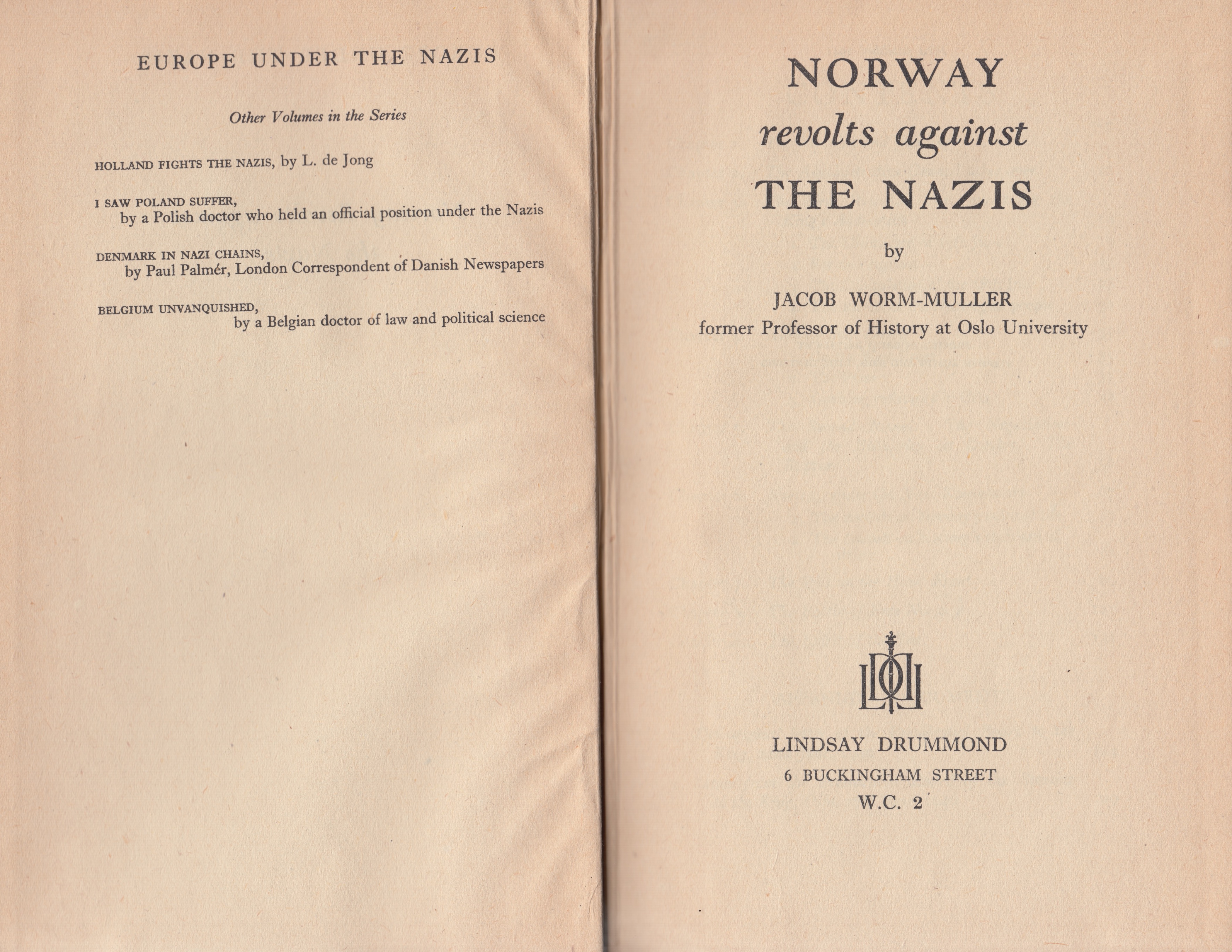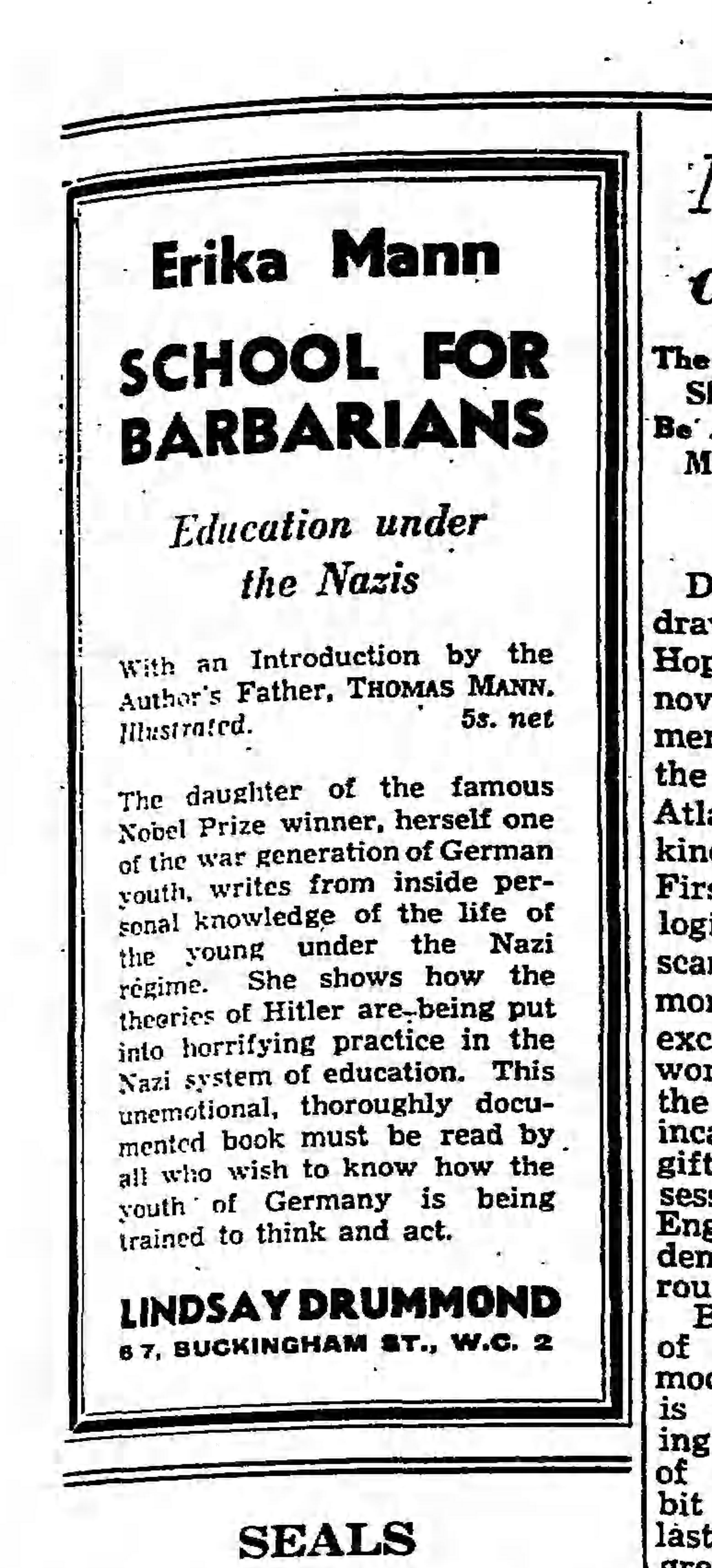Archive
Lindsay Drummond
- Lindsay Drummond
- Publishing House
The artist John Heartfield designed covers for the publishing house Lindsay Drummond, which had an anti-fascist programme and published books by emigrated authors such as Wilhelm Necker and Felix Langer.
Word Count: 30
6 Buckingham Street, Covent Garden, London WC2.

Paul Duner’s A Year and a Day (Lindsay Drummond, 1942) tells the story of the author's flight from Belgium to England (METROMOD Archive, © The Heartfield Community of Heirs / VG Bild-Kunst, Bonn 2021). Cover design by John Heartfield. 
Jacob S. Worm-Müller’s Norway Revolts Against the Nazis (Lindsay Drummond, 1941) with a cover design by John Heartfield (METROMOD Archive, © The Heartfield Community of Heirs / VG Bild-Kunst, Bonn 2021). 
Jacob S. Worm-Müller’s Norway Revolts Against the Nazis (Lindsay Drummond, 1941), title page (METROMOD Archive). 
Hans J. Rehfisch. In Tyrannos. Four Century of Struggle against Tyranny in Germany. Lindsay Drummond, 1943 (METROMOD Archive, © The Heartfield Community of Heirs / VG Bild-Kunst, Bonn 2021). First book publication of the émigré Club 43. Cover design by John Heartfield. 
Advertisement for Erika Mann’s School for Babarians. Education under the Nazis in The Manchester Guardian, 28 March 1939, p. 7 (Photo: Private Archive). 
Advertisement for Lindsay Drummond’s book series Europe under the Nazis in Freie Deutsche Kultur, no. 2, 1942, p. 14 (Deutsche Nationalbibliothek, Deutsches Exilarchiv 1933–1945, Frankfurt am Main). 
Advertisement for Edith Hoffmann’s Chagall. Watercolours 1942–46, Lindsay Drummond, 1947 in The Manchester Guardian, 13 January 1950, p. 4 (Photo: Private Archive). Bihler, Lori Gemeiner. Cities of refuge: German Jews in London and New York, 1935–1945. SUNY Press, 2018.
Brüning, Jens. “Karawanserei des alten Europas. Die Geschichte des Club 1943.” “I didn’t want to float; I wanted to belong to something.” Refugee Organizations in Britain 1933–1945 (Yearbook of the Research Centre for German and Austrian Exile Studies, 10), edited by Anthony Grenville and Andrea Reiter, Rodopi, 2008, pp. 67–88.
Buenger, Barbara Copeland. “John Heartfield in London, 1938–45.” Exil. Flucht und Emigration europäischer Künstler 1933–1945, edited by Stephanie Barron and Sabine Eckmann, exh. cat. Neue Nationalgalerie, Staatliche Museen zu Berlin, Berlin, 1997, pp. 74–79.
Schultz, Anna. “John Heartfield. A Political Artist’s Exile in London.” Burning Bright. Essays in the Honour of David Bindman, edited by Diana Dethloff et al., UCL Press, 2015, pp. 253–263.
Schultz, Anna. “Uncompromising Mimicry. Heartfield’s Exile in London.” John Heartfield. Photography Plus Dynamite, edited by Angela Lammert et al., exh. cat. Akademie der Künste, Berlin, 2020, pp. 195–202.
Sch., F. [Freimut Schwarz]. “Bücher: The German Army of To-day.” Freie Deutsche Kultur, no. 12, 1943, p. 10.
Necker, Wilhelm. Es war doch so schön!. Werner-Degener-Verlag, 1947.
Necker, Wilhelm. “Acht Stufen in die Emigration.” Sie flohen vor dem Hakenkreuz. Selbstzeugnisse der Emigranten. Ein Lesebuch für Deutsche, edited by Walter Zadek, Rowohlt, 1981, pp. 33–35.
Vinzent, Jutta. Identity and Image. Refugee Artists from Nazi Germany in Britain (1933–1945) (Schriften der Guernica-Gesellschaft, 16). VDG, 2006.
Word Count: 218
- 1937
- 1950
- London
- Burcu Dogramaci. "Lindsay Drummond." METROMOD Archive, 2021, https://archive.metromod.net/viewer.p/69/1470/object/5145-11259141, last modified: 21-06-2021.
-
John HeartfieldArtistGraphic DesignerFotomonteur (mounter of photographs)London
After escaping from his first exile in Prague in December 1938, the political artist John Heartfield lived in London since 1950, working for Picture Post and the publisher Lindsay Drummond.
Word Count: 28
Die ZeitungNewspaperLondonFrom 1941 to 1945, the émigré German-language newspaper Die Zeitung was published in London, reporting on the war on the continent and on the situation in Germany.
Word Count: 25
Freie Deutsche KulturNewsletterLondonThe Free German League of Culture was an association of emigrant artists and authors who organised exhibitions, concerts and lectures. The events were announced in the Freie Deutsche Kultur newsletter.
Word Count: 30
Ruth JacobiPhotographerNew YorkRuth Jacobi was a German-speaking, Polish-born photographer who emigrated in 1935 to New York, where she opened a studio together with her sister Lotte Jacobi. She later had her own portrait studio.
Word Count: 31
20th Century German ArtExhibitionLondonThe 20th Century German Art exhibition of 1938 gave visibility to artists who had been defamed at the Munich exhibition Entartete Kunst and were persecuted by the National Socialist regime.
Word Count: 29